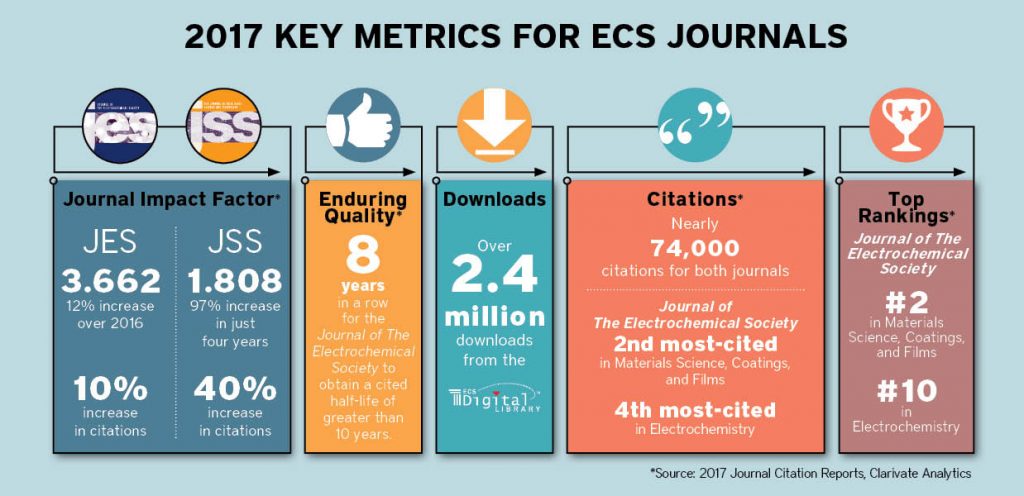The journal impact factors (JIFs) for the ECS journals continue to grow, as evidenced by the data recently released by Clarivate Analytics. For the 2017 reporting year, the ECS journals continue to be among the top-ranked journals. Journal of The Electrochemical Society (JES) is in the top two for Materials Science, Coatings, and Films; and in the top ten for Electrochemistry. The JIFs are published in Journal Citation Reports (JCR) and are just one metric used to gauge the quality of a large number of scholarly journals.
For the Journal of The Electrochemical Society (JES), the JIF rose to 3.662 for 2017 from 3.259 for 2016, an increase of over 12%. The enduring quality and usefulness of the work published in JES is significant: JES has had a cited half-life of greater than10 years (the highest figure that JCR records) for over eight years. JES is the fourth-most-cited journal in electrochemistry, with nearly 71,000 citations; that same citation count makes JES the second most-cited journal in materials science, coatings, and films. Downloads are another important metric for scholarly journals, and for the ECS journals, there were over 2.4 million downloads for 2017.
Within each ECS journal, the content is broken down by topical interest areas (TIAs). The ECS journals have a broad technical breadth and have over 25 competitors in each discipline. Looking closer at the JIFs for the individual TIAs, we see that the impact of the most prolific of those TIAs–Batteries and Energy Storage–has a JIF of 5.691, according it the number one rank in materials science, coatings, and films, and number four in electrochemistry.
For the ECS Journal of Solid State Science and Technology (JSS), the progress is also impressive: over 40% growth in citations for 2017 over 2016. In terms of the JIF, the growth for JSS is striking: the JIF has grown to 1.808 for 2017, from 0.917 in 2013 when JSS was launched–a 97% increase in just four years.
The increasingly influential role that the ECS journals play is due to the Society’s practice of rigorous peer review, which is based on rapid, objective, and insightful feedback, as well as evaluation for plagiarism. The relevance of the ECS journals is due to the increasing importance of the scientific content covered by the ECS journals: batteries and energy storage, corrosion, fuel cells and energy conversion, sensors, electrochemical engineering, organic and biological electrochemistry, physical and analytical electrochemistry, electrodeposition, nanocarbons, dielectrics, electronics and photonics, luminescence and display materials, and the many sub-disciplines within each.
In addition, ECS journals have a fast turn-around time: under 30 days from submission to a first decision–critical to authors who desire rapid recognition and visibility.
There is a great deal of discussion about the journal impact factors, including the lagging nature of the metric (the JIF looks only at three years of published articles and comes out six months after the end of the prior, or JIF, year). Many researchers, libraries, and funding agencies are debating the validity of the metric, as well as working on developing new ways of evaluating researchers for tenure and promotion.1-5 ECS is a member of the Declaration on Research Assessment (DORA), which “recognizes the need to improve the ways in which the outputs of scholarly research are evaluated. It is a worldwide initiative covering all scholarly disciplines and all key stakeholders including funders, publishers, professional societies, institutions, and researchers.”
ECS is grateful for the support of its authors, reviewers, editors, and publications staff. These are the people who are responsible for the high standards to which ECS adheres, and which keep the ECS journals growing in impact every year.
- P. Davis, “2017 Journal Impact Factors Feature Citation Distributions,” The Scholarly Kitchen, June 27, 2018, https://scholarlykitchen.sspnet.org/2018/06/27/2017-journal-impact-factors-feature-citation-distributions/.
- J. Wilsdon, “Has the Tide Turned Towards Responsible Metrics in Research?” The Guardian, July 10, 2018, https://www.theguardian.com/science/political-science/2018/jul/10/has-the-tide-turned-towards-responsible-metrics-in-research?CMP=Share_iOSApp_Other.
- D. Singh Chawla, “What’s Wrong with the JIF in 5 Graphs,” Nature Index, April 2, 2018, https://www.natureindex.com/news-blog/whats-wrong-with-the-jif-in-five-graphs.
- V. Lariviere, et al., “A Simple Proposal for the Publication of Journal Citation Distributions,” bioarxiv, July 6, 2016, http://dx.doi.org/10.1101/062109.
- J. Bohannon, “Hate Journal Impact Factors? New Study Gives You One More Reason,” Science, July 6, 2016, http://www.sciencemag.org/news/2016/07/hate-journal-impact-factors-new-study-gives-you-one-more-reason.
Mary Yess is the Society’s Chief Content Officer and Publisher.
http://orcid.org/0000-0003-3909-6524
@maryyess
https://osf.io/eznd3/



